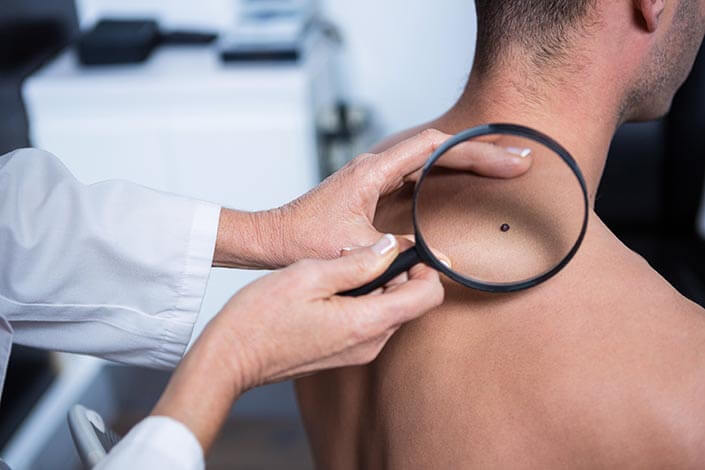Home » Our Services » Skin Cancer
Skin Cancer
What is Skin Cancer?
Skin cancer is one of the most common forms of cancer in the United States. It is caused by the abnormal growth of skin cells which cause a tumor. Skin cancer can affect the skin anywhere on the body but most frequently occurs in skin that is exposed to the sun such as the ears, nose and face.
Most skin cancers are caused by sun damage over time but there are many risk factors such as:
- Tanning bed use
- Multiple sunburns
- Fair skin
- Weakened immune system
- Age
- Abnormal moles
- Family history of skin cancers
Types of Skin Cancer
There are three most common types of skin cancer. They are named for the different types of skin cells that become cancerous.
Basal Cell Carcinoma
Basal cell skin cancer occurs in the basal cell layer of the skin and is the most common type of skin cancer in people with fair skin. It commonly occurs on areas of the skin that have been exposed to the sun, such as the face. It rarely spreads to other parts of the body.
Squamous Cell Carcinoma
Squamous cell carcinoma occurs in the squamous cells, and is the second most common type of skin cancer. It usually occurs in sun-exposed areas such as on the face, scalp, ears and neck. Squamous cell skin cancer can spread to lymph nodes or other parts of the body.
Melanoma
Melanoma is one of the most aggressive types of skin cancer, and the most likely to spread to other parts of the body. Melanoma occurs in the melanocyte (pigment) cells of the skin, and can form on any part of the body, regardless of past sun exposure.
Prevention of Skin Cancer
Although not every case of skin cancer can be prevented, the best way to avoid it is to protect skin from the sun. Recommendations for preventing skin cancer include the following:
- Limit exposure to the skin, especially between 10 a.m. and 4 p.m.
- Always wear sunscreen with an SPF rating of at least 15
- Wear a hat in the sun
- Wear long sleeves and long pants
- Avoid tanning beds and salons
Performing routine self-exams to spot skin changes or abnormal moles, and seeing a dermatologist for a full-body screening on a regular basis, is also recommended.
Symptoms of Skin Cancer
Skin cancer often starts as a mole or an abnormal growth on the skin. Skin cancers may appear as the following:
- Pearly or waxy bump
- Flesh-colored or brown scar-like lesion
- Firm, red nodule
- Crusted, flat lesion
- Large brown spot with darker speckles
- Shiny, firm bumps
The ABC’s of Skin Cancer
The ABC’s of skin cancer are an easy way to remember characteristics of a skin cancer and may be concerning. If you have a mole with these characteristics, you should have it evaluated by your physician.
- A – Asymmetry. A mole may be asymmetric.
- B – Borders. The borders of a mole are irregular.
- C – Color. Color changes or variation within a mole.
- D – Diameter. A diameter of more than 6 mm.
- E – Evolving. Changes in size, shape or color over time.
Diagnosis of Skin Cancer
To diagnose skin cancer, your doctor will review all your symptoms, and examine the skin for any unusual growths or abnormal patches of skin. If skin cancer is suspected, a biopsy may be performed on the area of skin in question. Once the results of the biopsy are reviewed, the presence and type of cancer can be determined, and a treatment plan created. Those who experience any skin changes, or have changes to existing moles or birthmarks, should see a doctor as soon as possible. Early detection is key in successfully treating skin cancer.
Treatment for Skin Cancer
Treatment for skin cancer depends on the type, size and location of the tumor. Most options include the removal of the skin cancer, and are effective forms of treatment. Some of the treatment options for skin cancer include the following:
- Freezing
- Excision
- Laser therapy
- Mohs surgery
Depending on the stage and severity of the skin cancer, in addition to removal of the growth, nearby lymph nodes may be removed and chemotherapy or radiation may be recommended.
Reconstruction After Skin Cancer Removal
After skin cancer is removed, there may be a wound or a defect that needs to be repaired. Repair of skin cancer defects is very important in order to have the best cosmetic and functional outcome, especially in the head and neck. Depending on the location of the defect various methods may be used for reconstruction including:
- Direct closure
- Skin grafts from other areas of the body
- Rotating in skin from immediately adjacent areas
- Using skin flaps from other areas in the region
- Free flap grafts from distant areas of the body such as the forearm or the thigh.
If the defect involves the nose, ear or other vital structures, sometimes bone or cartilage grafts are required to recreate the structure or support of certain areas. Some reconstructions are staged in multiple procedures depending on the reconstructive method used and type of skin cancer.





